|
|
|
Sort Order |
|
|
|
Items / Page
|
|
|
|
|
|
|
| Srl | Item |
| 1 |
ID:
093088
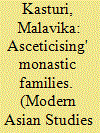

|
|
|
|
|
| Publication |
2009.
|
| Summary/Abstract |
This paper examines a fundamental premise of Anglo-Hindu law on succession between 1860 and 1940, that kinship was emblematic of secular modes of living, to analyse its implications for the assertion of masculinity within ascetic orders in northern India. Legal discourses engaged with rights to succession within ascetic orders, by functioning on the assumption that the renunciatory life of ascetics was antithetical to sexuality and domesticity. This institutionalization of law, that defined asceticism and fixed ascetic masculinities within a legal frame, occurred with the consent of ascetic orders concerned with the ownership and distribution of property, even though sexuality and gender played a central role in shaping relationships within sacred spaces. Myriad ties embracing the language of kinship shaped ascetic orders. Bonds of sentiment and sexual attachment over-lapped with, sustained, and produced the bonds tying spiritual preceptors to their disciples. Relationships within ascetic families, consisting of men, their female companions, children and relatives, along with their attendant obligations were validated through rights of ownership and inheritance to property. Taking advantage of Anglo-Hindu law by the early twentieth century, ascetic orders sought to 'purify' their genealogies through the medium of property disputes fought in colonial courts. By manipulating the legal meanings ascribed to asceticism, masculinity and renunciation, these orders effaced unwanted members from their orders with varying degrees of success, especially women and children.
|
|
|
|
|
|
|
|
|
|
|
|
|
|
|
|
| 2 |
ID:
093097
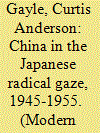

|
|
|
|
|
| Publication |
2009.
|
| Summary/Abstract |
Japanese images of China have much to tell us about the way Japan sees its own modernisation and its place in the international system. Contrary to popular belief, Japan did not turn unabashedly toward the USA after 1945. During the first decade after World War II, a number of important Japanese radical historians and thinkers decided that modernisation could be accomplished without the help of the West. Just when many in Japan were looking to America and Europe as exemplars of modernisation, others looked instead to revolutionary China and its past struggles against Japanese colonialism in the construction of a very different historical position from that ordinarily associated with the early post-war years. Certain Japanese historians, inspired by the push toward decolonisation in Asia, set about writing the history of the present in ways that aligned Japan with modern Chinese history. Even though China had just been liberated from Japanese colonial rule, Japanese Marxists saw their own position-under American imperialism-as historically and politically congruous with China's past war of resistance against Japan (1937-45). Through campaigns to develop a kind of cultural Marxism on the margins of Japanese society, they sought to bring about post-war Japanese 'national liberation' from American hegemony in ways that consciously simulated past Chinese resistance to Imperial Japan. Replacing Japan's own cultural Marxist traditions from the pre-war era with the more palpable and acceptable example of China, they also hoped a new form of Asian internationalism could remedy the problem of Japan's wartime past. The historical irony associated with this discursive twist deferred to future generations the problem of how the Left* would come to terms with the past.
|
|
|
|
|
|
|
|
|
|
|
|
|
|
|
|
| 3 |
ID:
093094
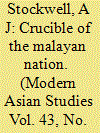

|
|
|
|
|
| Publication |
2009.
|
| Summary/Abstract |
Like so many features of the British Empire, policy for colonial higher education was transformed during the Second World War. In 1945 the Asquith Commission established principles for its development, and in 1948 the Carr-Saunders report recommended the immediate establishment of a university in Malaya to prepare for self-government. This institution grew at a rate that surpassed expectations, but the aspirations of its founders were challenged by lack of resources, the mixed reactions of the Malayan people and the politics of decolonisation. The role of the University of Malaya in engineering a united Malayan nation was hampered by lingering colonial attitudes and ultimately frustrated by differences between Singapore and the Federation. These differences culminated in the university's partition in January 1962. In the end it was the politics of nation-building which moulded the university rather than the other way round.
|
|
|
|
|
|
|
|
|
|
|
|
|
|
|
|
| 4 |
ID:
093090


|
|
|
|
|
| Publication |
2009.
|
| Summary/Abstract |
Mundane knowledge of how information flows is essential for a proper understanding of large organisations and complex activities. It gives us valuable insights into the prevailing constraints of the era and the creative responses that enabled the demands of its cosmopolitan residents to be met. Though the sinews of communication have been a major topic of historical inquiry in recent decades, the focus has been decidedly uneven; much of the attention has been directed towards modern times and, for earlier periods, has been confined almost entirely to Europe, the western European empires and those sectors of the world's political economy in which Europeans had a stake. The rest of the world, in comparison, has been neglected, which may be seen clearly in the case of early modern India and the Middle East. This paper seeks to rectify the imbalance by offering a typology for making sense of how packages of low weight and high value were collected, transported and delivered over long distances within the region in the eighteenth century. While drawing on a wide range of sources, at the core of this analysis lies the correspondence of the headmen of a group-the Aiyangar pattamars-who specialised as couriers in pre-colonial southern India. Among the principal claims set forth are that there existed in this period two basic modes of private communication: in one, personal trust was paramount, in the other, the mode was effectively monopolised by recognised communities providing the necessary informational services within their cultural domain. These claims, if sustained, have major implications for current views on early modern India and the Middle East.
|
|
|
|
|
|
|
|
|
|
|
|
|
|
|
|
| 5 |
ID:
093096
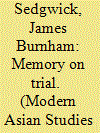

|
|
|
|
|
| Publication |
2009.
|
| Summary/Abstract |
The spectre of the 1937 'Rape of Nanking' continues to haunt China and Japan. Sixty years ago in Tokyo, the International Military Tribunal for the Far East (IMTFE) announced its definitive 'judgement' of what happened in Nanking. This judgement purported to be intractable. The legal process used to reach it produced a disputed picture instead. The resulting narrative confusion continues to inform how memory of Nanjing is shaped, used and contested. This paper explores the construction of 'Rape of Nanking' narratives at the IMTFE. By demonstrating the inherently contested nature of narratives produced by adversarial legal proceedings, it argues that using courts as a panacea for postwar restoration and as validators of traumatic narratives is both short-sighted and ineffective. The IMTFE exemplifies the inadequacy of trial-based post-conflict reconciliation. It is hoped that the lessons learned from Tokyo's limitations will benefit the ongoing quest for tenable models of international justice.
|
|
|
|
|
|
|
|
|
|
|
|
|
|
|
|
| 6 |
ID:
093095
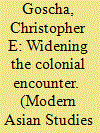

|
|
|
|
|
| Publication |
2009.
|
| Summary/Abstract |
Relying on three inter-Asian colonial debates from French Indochina, this paper attempts to widen our analytical approach to the study of colonialism in Indochina beyond the 'colonizer'-'colonized' opposition by factoring in the relationships among the diverse Asian colonized living within the colonial state without downplaying the important role Western colonialism played in transforming those very relationships or being affected by them. The French Indochinese case is helpful, for it suggests that inter-Asian connections did anything vanish, but rather intensified because of the colonial experience. Numerous Lao, Khmer, Vietnamese and Chinese subject elites continued to engage each other and the French in fascinating and sometimes heated debates about the political, legal, cultural and economic place each group held in French Indochina - or did not want to hold. This directly affected how they came to interact with one another in new ways, essential to understanding the complexity of the colonial encounter at the time and can provide new insights into post-colonial and international history. Lastly, this wider approach to studying the colonial encounter allows us to view the French side of the colonial equation from a new vantage point.
|
|
|
|
|
|
|
|
|
|
|
|
|
|
|
|
| 7 |
ID:
093092
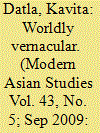

|
|
|
|
|
| Publication |
2009.
|
| Summary/Abstract |
Twinned as Urdu has become with the fate of India's largest religious minority, Muslims, and with the emergence of the independent state of Pakistan, for which Urdu is the official national language, the story of Urdu holds a peculiar place and a special significance in histories of the subcontinent. Stories of the Urdu language are dramatic, bound up as they are in questions of politics, the fate of Hindus and Muslims and the vicissitudes of both the Urdu and the Hindi languages. Though Hindi-Urdu language politics are an important part of these languages' colonial history, this article emphasizes another story. For, like the other vernaculars of south Asia, Urdu had to contend as much with English as with Hindi, and it is that story that is emphasized here. This article details how early-twentieth-century Hyderabad's Urdu educators engaged with questions of native education, language, and Western science. It highlights the discussions and disagreements that accompanied this educational project as Urdu advocates re-evaluated their language and its sources of authority, attempting to make the Urdu language a worldly vernacular, useful for more than the subcontinent's Muslim population.
|
|
|
|
|
|
|
|
|
|
|
|
|
|
|
|
|
|
|
|
|